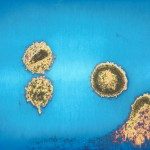Link to Pubmed [PMID] – 23523133
Link to DOI – 10.1016/j.virol.2013.02.008
Virology 2013 May; 440(1): 8-18
The early steps of HIV-1 replication involve the entry of HIV-1 into the nucleus, which is characterized by viral interactions with nuclear pore components. HIV-1 developed an evolutionary strategy to usurp the nuclear pore machinery and chromatin in order to integrate and efficiently express viral genes. In the current work, we studied the role of nucleoporins 153 and 98 (Nup153 and Nup98) in infection of human Jurkat lymphocytes by HIV-1. We showed that Nup153-depleted cells exhibited a defect in nuclear import, while depletion of Nup 98 caused a slight defect in HIV integration. To explore the biochemical viral determinants for the requirement of Nup153 and Nup98 during HIV-1 infection, we tested the ability of these nucleoporins to interact with HIV-1 cores. Our findings showed that both nucleoporins bind HIV-1 cores suggesting that this interaction is important for HIV-1 nuclear import and/or integration. Distribution analysis of integration sites in Nup153-depleted cells revealed a reduced tendency of HIV-1 to integrate in intragenic sites, which in part could account for the large infectivity defect observed in Nup153-depleted cells. Our work strongly supports a role for Nup153 in HIV-1 nuclear import and integration.



